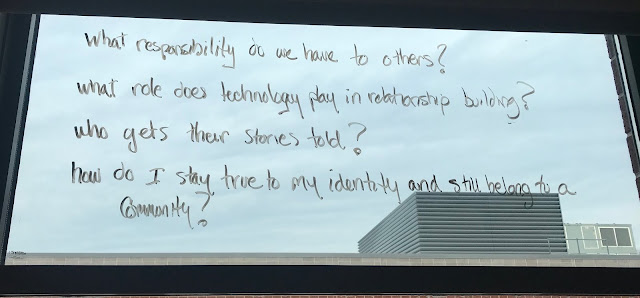Also -
If you are still using .PPT or Prezi consider this - "There are many different guidelines about the maximum number of words that should be on one slide. The rule of 4 by 5 says four bullet points of five words each. The rule of 33 says a maximum of 33 words per slide." http://virtualsalt.com/powerpoint.htm
Finally,
Presentation Zen shares a few different ways to consider when planning your presentation
• Presenting fully naked, no slides, no script
Sir Ken Robinson: Do schools kill creativity? Sir Ken knows what he wants to say and usually has 2-3 key points in mind, but he does not read a script or use notes. He makes good use of humor and story to illustrate his points.
Sir Ken Robinson: Do schools kill creativity? Sir Ken knows what he wants to say and usually has 2-3 key points in mind, but he does not read a script or use notes. He makes good use of humor and story to illustrate his points.
• Presenting with highly visual slides in the PZ style
Seth Godin: Why tribes, not money or factories, will change the world. Seth uses many, large colorful slides in his talks but the slides have very little (if any) text. Seth is out front totally engaged.
• Presenting with slides kind of like Al Gore
Al Gore: 15 ways to avert a climate crisis. Al Gore became an engaging presenter with the aid of simple, high-impact visuals that helped him tell the story and give evidence supporting his content.
• Using a prepared script from the lectern (no slides)
Isabel Allende: Tales of passion. In general, I do not recommend reading a speech at such a conference, but if you do read, do it in a way that is engaging as demonstrated by Isabel Allende.
• Using a prepared script from the lectern (with slides/video)
Sylvia Earle (TED Prize winner 2009). Although Dr. Earle was using a script, she knew her material so well that it felt natural and the pacing was almost perfect with the visuals.
Seth Godin: Why tribes, not money or factories, will change the world. Seth uses many, large colorful slides in his talks but the slides have very little (if any) text. Seth is out front totally engaged.
• Presenting with slides kind of like Al Gore
Al Gore: 15 ways to avert a climate crisis. Al Gore became an engaging presenter with the aid of simple, high-impact visuals that helped him tell the story and give evidence supporting his content.
• Using a prepared script from the lectern (no slides)
Isabel Allende: Tales of passion. In general, I do not recommend reading a speech at such a conference, but if you do read, do it in a way that is engaging as demonstrated by Isabel Allende.
• Using a prepared script from the lectern (with slides/video)
Sylvia Earle (TED Prize winner 2009). Although Dr. Earle was using a script, she knew her material so well that it felt natural and the pacing was almost perfect with the visuals.
• Presenting well in spite of superfluous, cruddy bulleted slides
Tony Robbins: Why we do what we do. Tony Robbins speaks for a living, and while I do not recommend swearing from the stage, Tony was able to engage a rather skeptical audience at TED in spite of poor visuals. Watch the presentation to see how.
• Presenting in a way that makes an amazing connection with the audience
Jill Bolte Taylor: My stroke of insight. Dr. Taylor uses some slides and one prop (an actual human brain), but mainly she lets her emotions out and tells her story in an honest, sincere way. Amazing.
• Presenting data with slides to tell meaningful stories
Hans Rosling: Debunking third-world myths with the best stats you've ever seen.Who says data is boring? Data is like notes on a page, says Dr. Rosling, it's up to the presenter (the conductor) to bring the data (music) alive for the people.
Tony Robbins: Why we do what we do. Tony Robbins speaks for a living, and while I do not recommend swearing from the stage, Tony was able to engage a rather skeptical audience at TED in spite of poor visuals. Watch the presentation to see how.
• Presenting in a way that makes an amazing connection with the audience
Jill Bolte Taylor: My stroke of insight. Dr. Taylor uses some slides and one prop (an actual human brain), but mainly she lets her emotions out and tells her story in an honest, sincere way. Amazing.
• Presenting data with slides to tell meaningful stories
Hans Rosling: Debunking third-world myths with the best stats you've ever seen.Who says data is boring? Data is like notes on a page, says Dr. Rosling, it's up to the presenter (the conductor) to bring the data (music) alive for the people.
• Presenting in sync with many, many slides
Larry Lessig: How creativity is being strangled by the law. Who says you can't speak well to 200 PowerPoint/Keynote slides? No one does it like Prof. Lessig.
• Presenting from the piano, the stage, & within the audience
Benjamin Zander: Classical music with shining eyes. What can I say? If you present with even half the conviction and passion of the great Benjamin Zander, conductor of the Boston Philharmonic and loyal TEDster, you will blow their socks off.
Larry Lessig: How creativity is being strangled by the law. Who says you can't speak well to 200 PowerPoint/Keynote slides? No one does it like Prof. Lessig.
• Presenting from the piano, the stage, & within the audience
Benjamin Zander: Classical music with shining eyes. What can I say? If you present with even half the conviction and passion of the great Benjamin Zander, conductor of the Boston Philharmonic and loyal TEDster, you will blow their socks off.


No comments:
Post a Comment